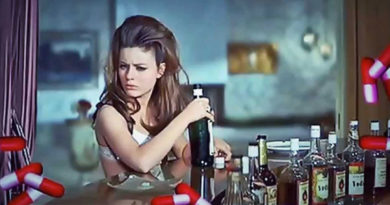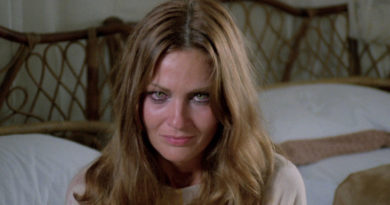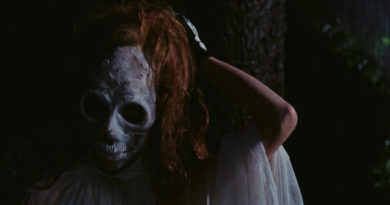The ‘Horror Hag’ Genre — Part One
 Yes, “Horror Hag” is a rude and extremely un-PC moniker, but that’s what the stars of the ’30s and ’40s became in the ’60s. Too long in the tooth to play romantic leads, too stylized in appearance and performance to blend in with the mainstream entertainment of the time, these actresses took the roles that were offered them — and more and more, these roles were in the realm of horror.
Yes, “Horror Hag” is a rude and extremely un-PC moniker, but that’s what the stars of the ’30s and ’40s became in the ’60s. Too long in the tooth to play romantic leads, too stylized in appearance and performance to blend in with the mainstream entertainment of the time, these actresses took the roles that were offered them — and more and more, these roles were in the realm of horror.
Joan Crawford and Bette Davis had both been superstars at their respective studios (MGM and Warners), but by 1962 they were taking bit parts or making occasional television appearances when director Robert Aldrich approached them to star in Whatever Happened to Baby Jane?, the grandmother of the Horror Hag genre.
Davis stars as Jane Hudson, a former child star (“Baby” Jane) who has impossible aspirations of reviving her long-faded career. Crawford is Blanche, Jane’s reclusive, invalid sister, who had been a famous star in the ’30s after Jane’s young career had ended. Wheelchair-bound and totally dependent on Jane, she must tolerate her drunken, delusional sister’s abusive treatment day after day.
A prologue, set in the teens, shows young Blanche watching jealously in the wings while Jane struts onstage, singing treacly songs and being nauseatingly cute. Then, in the ’30s, Blanche becomes famous while Jane is laughed off the screen by movie executives who groan over her lack of talent. An automobile “accident” results in Blanche’s paralysis, and the guilt-ridden but hostile Jane becomes Blanche’s unwilling caregiver. Aldrich takes full advantage of the real-life, longstanding feud between the two volatile actresses and gives Davis some wonderfully choice lines which have since become iconic:
Blanche: You wouldn’t be able to do these awful things to me if I weren’t still in this chair.
Jane: But ya are, Blanche! Ya are in that chair!
Davis fearlessly tore into her character, creating a garish white makeup because she reasoned that “Jane never washed her face — just kept adding a new layer of makeup every day.” Crawford, meanwhile, refused to let herself look bad and is consequently the most glamorous invalid you’ve ever seen.
For the climactic beach scene, in which the supposedly starving-to-death Blanche is perishing, Crawford put on a pair of enormous falsies that made Bette exclaim, “Let’s face it. When a woman lies on her back, I don’t care how well-endowed she is, her bosoms do not stand straight up. And Blanche had supposedly wasted away for twenty years. The scene called for me to fall on top of her. I had the breath almost knocked out of me. It was like falling on two footballs!”
Aldrich also casts Davis’ own daughter, B.D., in a small role as the next-door neighbor, whose mother asks her if she’s ever caught a glimpse of Blanche Hudson, to which she replies, “No, all I ever see is that fat sister.”
The casting stunt — and great movie, by the way — translated into boxoffice gold and an Academy Award nomination for Davis. On Oscar night, she lost to Anne Bancroft for The Miracle Worker. Crawford had made a prior arrangement to accept the award for the younger actress, who was unavailable to appear, and she regally swept past her seething rival to take center stage.
Nevertheless, money spoke louder than hatred, and Aldrich cast them in his follow-up, Hush…Hush, Sweet Charlotte (1964). By this time, though, Davis was in full battle mode, and she literally drove Crawford off the set with histrionics: complete alignment with the crew, interruptions during Crawford’s scenes and general mayhem. Crawford checked into a hospital and refused to leave until she was released from her contract.
Davis persuaded her pal Olivia De Havilland to take Crawford’s role, and the result is still a good film. Davis plays Charlotte, a faded and off-her-rocker Southern belle who refuses to leave her plantation home when the state wants to build a highway through her property. De Havilland is her sweet-seeming but scheming cousin who arrives to persuade Charlotte to leave. It doesn’t have the high-camp histrionics of Jane, settling instead for a decent story and solid performances from Davis, De Havilland, Joseph Cotten, old-timer Cecil Kellaway and especially Agnes Moorehead as Charlotte’s slatternly maid. Another old Davis nemesis, Mary Astor (The Old Maid), appears in the film as well, but Aldrich wisely avoided putting her in any scenes with the explosive star.
Crawford hit the horror hag circuit in earnest with director/showman William Castle’s Strait-Jacket (1964). She plays Lucy Harbin, a woman confined to an asylum after she chops up her husband (Lee Majors!) and his tootsie with an axe when she catches them in bed. Years later, she is released to the care of her equally nutso daughter, Carol (Diane Baker), who’d witnessed the murder. Of course, deaths by hatchet start all over again.
As she did in all of her subsequent “horror hag” roles, Crawford delivers an all-in performance, giving the “B” material some class. But don’t think it’s a sincere character study — it’s a riot. The hatchet killings are surprisingly brutal for their time (apart from some extremely obvious rubber heads, which only add to the fun). There’s a scene in which Lucy, persuaded by Carol to dress in her old trampy clothes (guess she used to be the Town Pump and Carol loved it), meets her daughter’s fiance for the first time and rubs her hands all over his face, even sticking her fingers in his mouth. And she lights her cigarette with a match that she strikes on the grooves of a phonograph record.
Meanwhile, Davis appeared in Dead Ringer (1964), directed by her former costar Paul Henreid (remember the two cigarettes in Now, Voyager?). It’s not really a horror film, but Davis plays a dual role as twin sisters, one of whom murders the other and assumes her identity. If you are a fan of Davis’ trademark quirky acting, it’s a must-see. She smokes so much that you can barely see her behind the perpetual cloud. And here she’s at her twitchiest, eyeballs popping around and hands flapping all over the place. It’s truly Bette Davis playing the role of a Bette Davis impersonator. Click here to see the best one — the late, great Charles Pierce.
The murder scene is hilarious. After Edith shoots her sister (very cleanly, I must say), she plants a suicide note, restyles both of their absurd hairdos (the bunches of hair around the ears hide the adhesive “lifts” Davis used), and even sings a froggy version of “Shuffle Off to Buffalo” to put her detective boyfriend Karl Malden (yes, I said Streets of San Francisco‘s Karl Malden) off track. But when she assumes her wealthy sister’s identity after the death of said sister’s husband — whom they both loved, by the way — she discovers that her sister had a double life herself and a younger lover in the personage of unctuous Peter Lawford. What a sadistic revenge! Even John F. Kennedy said, “Yeccch — Peter Lawford!”
Dead Ringer also boasts an appearance by the perpetually ancient actress Estelle Winwood (Bert I. Gordon’s The Magic Sword), who lived to 102 and was 79 or 80 when this film was made. She plays the twin sister’s dead husband’s aunt or mother or something…anyhow, she always wants to make Edith pray whenever she appears onscreen. Hilarious.
 While Davis was shooting Charlotte, Crawford continued her collaboration with Castle, albeit in a bit part, with his heckuva lot of fun I Saw What You Did (and I Know Who You Are). Two teenage girls make prank phone calls, repeating the titular line, and draw the ire of newly-minted murderer John Ireland, who has just offed his wife in a shower stabbing scene that Castle intended to be even more extreme than Psycho.
While Davis was shooting Charlotte, Crawford continued her collaboration with Castle, albeit in a bit part, with his heckuva lot of fun I Saw What You Did (and I Know Who You Are). Two teenage girls make prank phone calls, repeating the titular line, and draw the ire of newly-minted murderer John Ireland, who has just offed his wife in a shower stabbing scene that Castle intended to be even more extreme than Psycho.
Crawford appears in a few scenes as Ireland’s lover, purring and rubbing up against him. It’s disturbing. By this time, the 60-year-old actress was feeling delicate about how she was photographed, so she insisted that her cameramen cast her wrinkly parts in shadow. Check out the makeup tests below. By the time she made her last Horror Hag movie, she had great swashes of darkness cast across most of her body except her eyes. But that story is to come…
De Havilland, who has been so sophisticated and tasteful in retirement (and is still with us), was somehow talked into further horror hagdom with Lady in a Cage (1964), a surprisingly violent and nasty film featuring an early appearance by James Caan as a thug who barges into a wealthy invalid’s home and terrorizes her. Combining the new permissiveness of the swinging ’60s with blecchsploitation, this movie is just sort of…creepy.
Not campy or really very fun, it earns marks for its progressive sleaziness, but it’s unpleasant to see the elegant De Havilland put through the paces that Davis would handle with chain-smoking aplomb. Of course, Davis would never play the victim. Ironically, when I was child, my family would go to my grandparents’ house after church on Sunday and this film would often be showing on television — uncut — on the daytime movie matinee (along with The Birds and I Saw What You Did)!
End part one. In the meantime, check out these makeup tests for Joan Crawford in Strait-Jacket. Note this clapboard says “Age 29.” Uhhh, what?

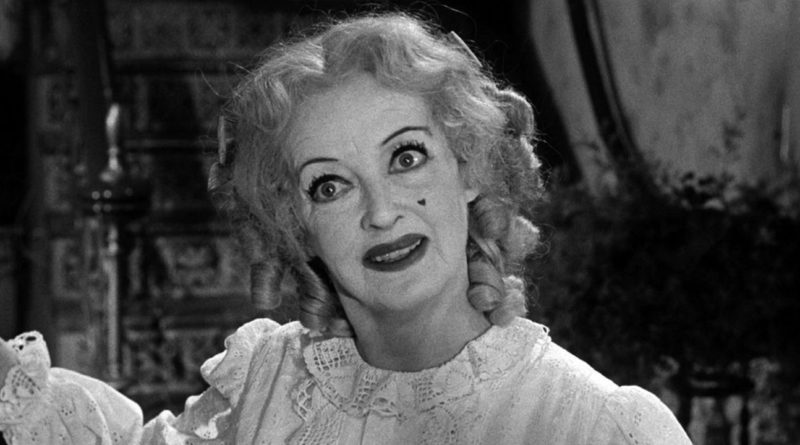



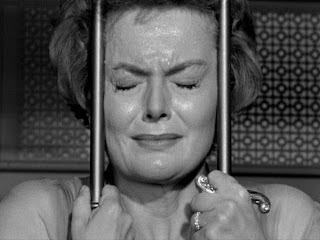_NRFPT_01.jpg)
